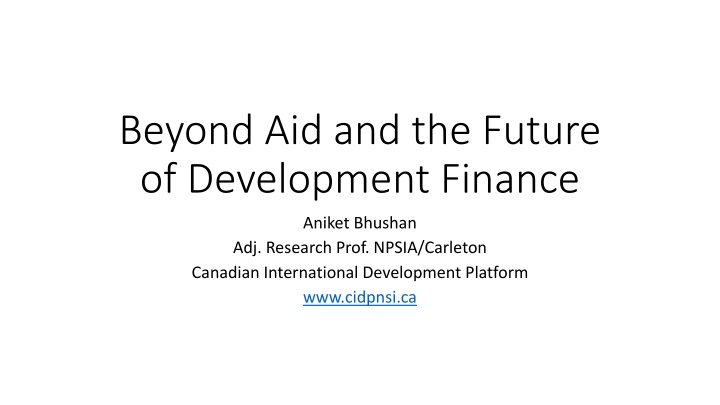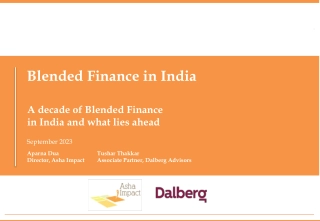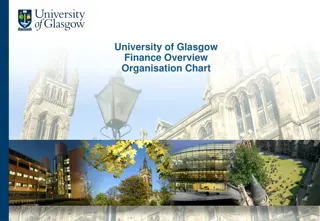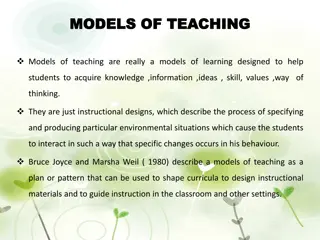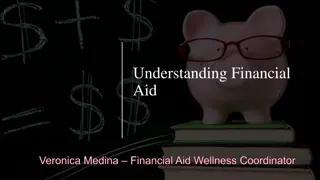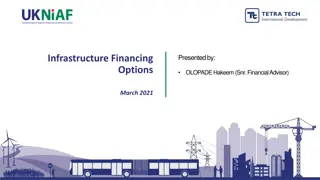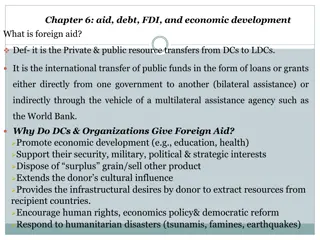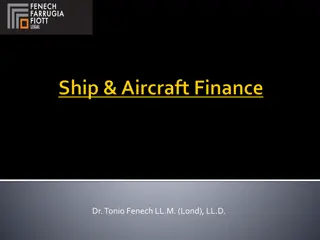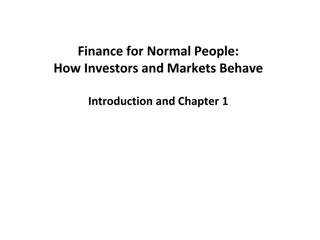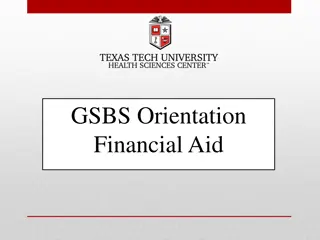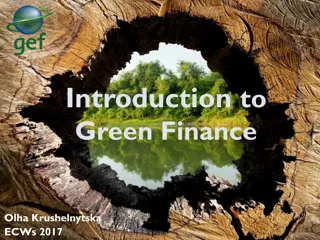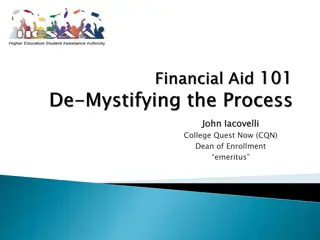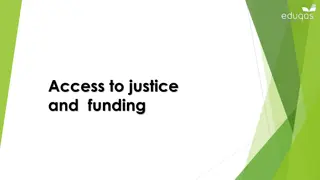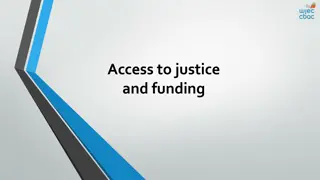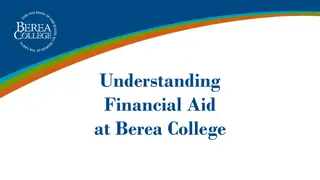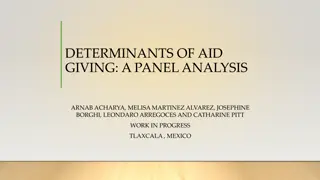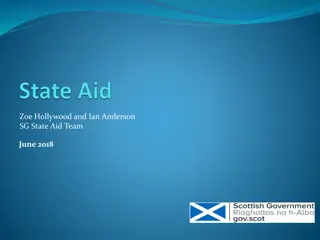Development Finance and Innovative Models in Aid
The evolution of aid as a financial innovation, the theory behind aid financing, and the flaws in present aid goals. Delve into data on aid targets, investments, and more. Discover new perspectives on aid and development finance.
Download Presentation

Please find below an Image/Link to download the presentation.
The content on the website is provided AS IS for your information and personal use only. It may not be sold, licensed, or shared on other websites without obtaining consent from the author.If you encounter any issues during the download, it is possible that the publisher has removed the file from their server.
You are allowed to download the files provided on this website for personal or commercial use, subject to the condition that they are used lawfully. All files are the property of their respective owners.
The content on the website is provided AS IS for your information and personal use only. It may not be sold, licensed, or shared on other websites without obtaining consent from the author.
E N D
Presentation Transcript
Beyond Aid and the Future of Development Finance Aniket Bhushan Adj. Research Prof. NPSIA/Carleton Canadian International Development Platform www.cidpnsi.ca
Outline Part 1 Setup: theory and quick overview of data Part 2 Development finance and innovative finance terrain Illustrative mechanisms/models in further detail Part 3 Interactive exercise
Theory Aid, when conceived, was itself a financial innovation grounded in equal parts politics, charity, sophisticated economic theory (in its day), turned into policy innovation Two gap model (Harrod-Domar, Rostow, Chenery ): development/growth take-off is limited by investment. Investment is limited by savings. Growth is a joint function of savings and ICOR (the units of capital required to produce a unit of output), i.e. s = k*g or g =s/k (adapted to second gap forex)
Theory Assumptions All savings drive investment All investment drives growth There are no frictions, there are no transaction costs All aid, essentially, investment
Theory Back-envelope calculation (Rosenstien-Rodan) showed in 1960s capital needs would be around $10bn which happened to be 1% of rich country GNI Capital flows were 0.6 to 0.8% of rich GNI about 2/3 tended to be aid Mix of target aversion and ambition arrived at relatively random compromise of 0.7, aimed mainly at US (which would never commit) Direction reverse staring point rich income, not poor need/cost No real logic as to why static share of rich income determines financing in unrelated disconnected context
Theory Intuitively appealing but flawed Present day financial flow conditions gives an aid goal of around 0.01% of advanced economies GDP towards aid in the poorest countries and implies negative aid flows to the developing world as a whole Why?
Data What does aid target/fund/buy? Aggregate DAC level / Canada How does it compare? Investment, remittances, OOF, etc. Aggregate level / Canada
What does aid target/fund/buy? Has changed over time From economic (hard) infrastructure and productive sectors quarter or less (Canada lower) To mostly social infra health, education, governance, other social more than half
The spectrum Logic of investment Logic of intervention Basic survivalist Thriving society Resilience Emergency response Contain fallout Equitable growth Long term economic development Socioeconomic transformation
What does aid target/fund/buy? Less and less investment Stretched capacity, compounding needs testing serial intervention
Data What about the pattern of flows, how does aid compare? Several possible frameworks (Monterrey, FfD, Kharas et al.) Simple: Concessional vs. non-concessional (market) finance; Domestic vs. external/non-domestic Elaborate: Private flows FDI, portfolio investment, philanthropic; Other official flows (e.g. export credits); Remittances; and more
Canadas exposure to emerging markets and developing countries Limited compared to other developed economies Trade with SSA and SA, while growing, < 1% of Canada s trade Trade with LICs < 0.5% However, value of imports into Canada from LDCs and LICs is 2x the amount of aid from Canada to the same countries Total (stock) Canadian FDI in all developing countries doubled (2001-11), but, only 2% of total; poorest < 0.2% Remittances to all aid recipient developing 5x aid; but, in the poorest aid = approx. 5x remit from Canada
Inflection point pick a camp Aid is essential for developing countries, for their development Being a donor is essential for us, for our relationship with developing countries and relationship with other donors and likeminded actors
Innovative finance landscape Public (taxpayer) money will not be enough Limited tools, models of allocation leave gaps Not just finance, but innovation in modalities Innovation to address incentive problems, balancing ownership and capacity, pool capital and risk, and other known challenges Well known, well trodden Market access (preferential agreements LDCT, CMAI; GPT; CCCT; FTAs, FPIAs) A4T Conditional (and unconditional) cash transfer Remittance prices (e.g. 5x5) Address frictional/transactional costs and inefficiencies Blended finance
Innovative finance landscape models that aim to alter the incentive structure of aid allocation to leverage non-traditional capital, link aid more directly to the achievement of quantifiable results, motivate behavioral change and or to catalyze innovation MCC AMC, push pull mechanisms (Gavi, but also others) IFFIm (vaccine, Gavi) Cash on Delivery aid, other results-based / output-based Consumer initiatives (RED) Levy(s) (airline) Challenge funds
IFFIm: mechanism Vaccine bonds
Innovative finance landscape: prospects Distinction between development finance and finance blurs further Aid (re-emerges) as investment Development impact bonds (first issuance 2014) Diaspora bond (Israel since 1951; India opportunistic) Remittance flow securitization (Japan-BdB) Aid and other future flow securitization (resource receivables, ODA receivables, to some extent already e.g. IFFIm, minus securitization) Innovation in capital structure (new forms of mezzanine financing, risk insurance) Leverage to increase ODA (reflows) (AfD integration into French CDC)
DIB/SIB: mechanism 5(+1) key players and their roles: Intermediary: raises working capital/investment capital from investors (HNI, foundations, funds etc.) Service provider(s): implement innovative solutions Population/target: Independent evaluator: independently verifies and validates Outcome funder (gov., or third-party): if solution achieves predefined social outcome, pays investors, through the intermediary (share of savings), based on degree of outcome achieved Investors: provide capital, may also be charged fee by intermediary Returns ~= degree of outcome Risk transferred away from gov. to investor (to varying degrees)
DIB/SIB: mechanism Meaningful, measureable (in some cases monetizable) outcomes Time horizon that works across stakeholders Evidence and attribution Independence of evaluator Controls mitigate perverse incentives Legal and political factors Evidence anchored from the start Transfer of risk Aligned incentives (learning) Scale and link multi service providers
DIB/SIB: mechanism First SIB 2010 (UK), criminal justice (Peterborough prison), reduction in reoffending among short term (12month) young offenders, small GBP 5 million As of March 1, 2015 38 active SIBs, majority in UK, then US, Aus; Majority small (under 5mn); majority shorter term (20 to 60months, some in UK, US, Aus, 80 to 120 months); Most upfront capital commitment senior investment, followed by sub investment, recoverable grants, non-recoverable; Social welfare, employment, criminal justice, education Wide variation in target rates of return from 2% to 7.5% for senior investors, typically lower for sub (but also wide ranging in some cases much higher) Successes overall, but yes, some losses (e.g. NYC criminal justice SIB, but born by Goldman and Bloomberg Philanthropies)
DIB/SIB: mechanism First SIB in Canada May 2014, Saskatoon; supported living for single mothers in unhealthy family environments; 5yr; $1.4mn upfront capital; 5% return First DIB 2014, India UBS Optimus Foundation, Children s Investment Fund Foundation, Educate Girls and Instiglio announced Development Impact Bond (DIB) pilot to improve educational outcomes in Rajasthan, India. DIBs under development include Uganda (sleep sickness, education, family planning), South Africa (criminal justice, SME business development, TB prevention), Mozambique (malaria), Morocco (youth employment), Ghana (SME development and workforce training)
Innovative finance: challenge Not true to development distracts or worse detracts from priority issues in core countries/regions areas of concern Misdiagnosis of problem to what extent is low investment a risk perception problem, info asymmetry problem, frictional/transactional cost problem Wrong solution at what point does subsidizing risk create bigger distortion, when does incentivising innovation or lowering entry barriers become offloading risk or burden of proof (challenge funds)
Catalyst for change Not financial innovation but what financial innovation can unlock Change orientation and mentality (top down aid planner mentality to bottom up explore/innovate) New partnerships, collaborations, stakeholders; including but not limited to crowding in private capital Metric driven focus on outcomes; not just data-driven but data being used in near real time for actual decision making and adaptation by those generating it (miles from donor reporting and roll up!) Truly independent verification and validation, and innovation in the same Experimentation and ultimately, hopefully, innovation, in service delivery and final outcomes
Interactive exercise Design a policy idea (innovation or intervention) backed by analysis, focusing on the core mechanism, stakeholders, market(ing), risks, payoff expectations and present to challenge panel 1. Design investment framework for DFI keeping double bottom line in mind (development outcome and ROI), suggest what the first investment should be, where and why 2. Suggest aid allocation formula that takes into account beyond aid dynamics, apply to current priorities and describe if and what change, pick a country/region, design a strategy that would help fill assessed gap 3. Design an innovative financing strategy for one of the SDG/GG, which is costed beyond levels achievable via current aid/concessional financing levels, incorporate development finance innovation, describe why that innovation and why it may work 4. Present a rationale for the first Canadian development impact bond, describe its mechanism, why and how it could work, embedded risks and risk mitigation, how it would be marketed, and what expectations stakeholders (all stakeholders investors, issuers, investment beneficiaries) should have 5. Design a financial product that will help diversify Canada s trade and investment footprint into potentially higher return frontier/LD/fragile markets but where structural constraints limit exposure
